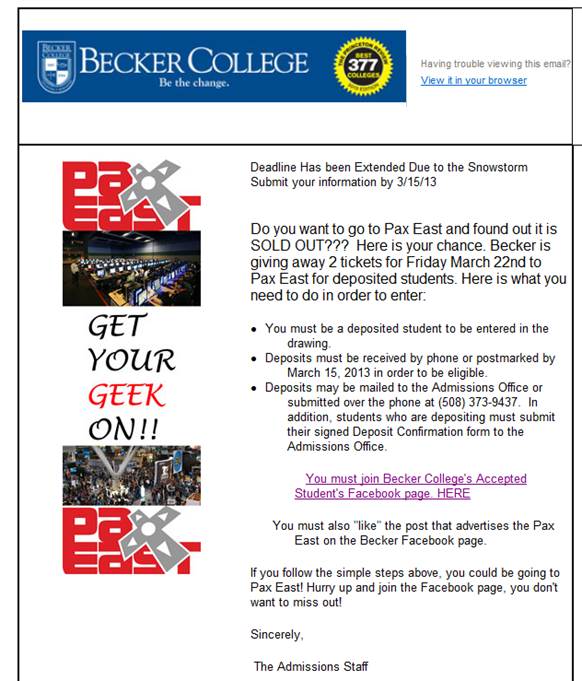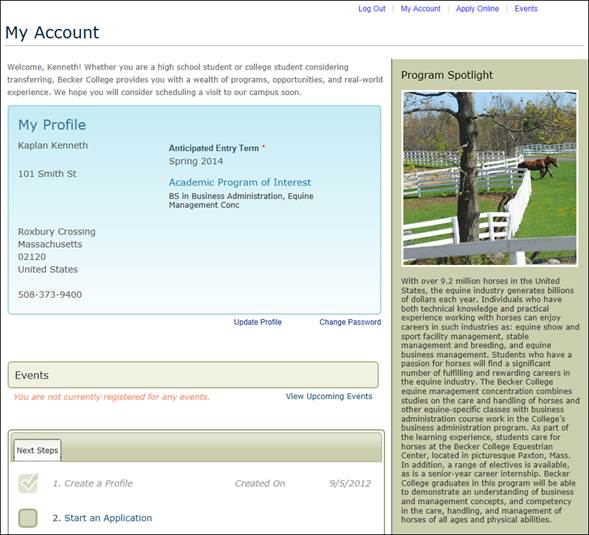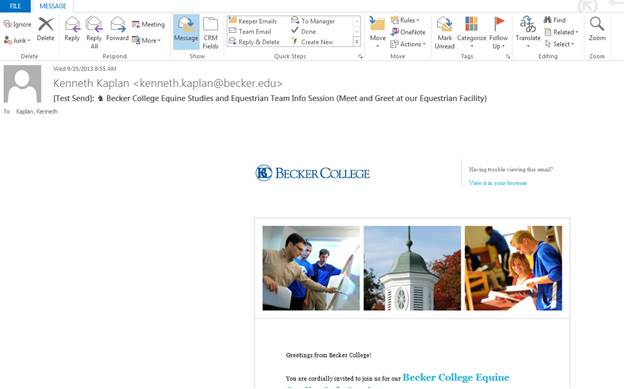Key Takeaways
- To personalize and increase communications with prospective students, Becker College implemented new recruiting software that yielded benefits both to the prospects and to the college through increased inquiries, applications, and acceptances.
- The software's automated processes let Becker increase the touch points with prospects from five to 15 or 20 — without additional Admissions staff.
- The solution also let the college improve its internal review and acceptance process and streamline its SAT import process — changes that not only make life easier for its counselors, but facilitate more rapid communications with prospective students.
To gain prospective students' attention, an institution's communications must be personalized, relevant, and frequent. At Becker College, we focused on these three points in 2011 to create strategic prospect campaigns, and our efforts paid off: over the last two years, we've experienced a 55 percent increase in applications, a 34 percent increase in accepted students, and a 12 percent increase in deposited students.
Our goal in implementing these strategies was to make more prospects aware of Becker's academic offerings and national reputation: Princeton Review ranked Becker in both The Best 378 Colleges, 2014 Edition and The Best 377 Colleges, 2013 edition. Also, the Princeton Review publication noted many of our individual academic programs — including computer game development, veterinary science, business, education, and nursing — for their high quality. In fact, for the past four consecutive years, Princeton Review has named Becker among the top colleges in the U.S. and Canada for video game design. Becker's unique class options and hands-on, professional approach to higher education make the college attractive to prospects, but in 2011 our profile remained lower among prospective students than such public recognition might suggest.
Personalizing Prospect Contacts
In the past, admissions staff typically sent a prospect two or three letters via mail and then followed up with a few phone calls. Our existing recruiting software was at end-of-life, and we knew that the college needed a new tool to keep pace with Becker's evolving business methodology and growth. We needed a software solution that was more flexible, could provide better information for decision making, and could automate existing processes. Our ultimate goal was to find a solution that could not only help the college remain competitive but also help us stay ahead of the curve when reaching out to prospective students.
In 2011, we decided to implement Ellucian Recruiter to increase awareness of our positive reputation and academic offerings among college-bound students. We also wanted to automate our processes so we could deliver more — and more effective — communications.
The college wanted a solution that was flexible enough to accommodate our changing business requirements, but robust and easy to use to allow for increased personalization and tracking of key data. Becker's initial Recruiter deployment was a bit rocky. We faced inconsistent integration issues with our student information system (Colleague by Ellucian), significant retraining of Admissions staff, and difficulty with reporting. However, Becker's Admissions and Information Technology staff worked with the Recruiter product management staff at Ellucian to address technical difficulties. The IT staff also shifted on-site resources so that existing employees could become proficient in Recruiter, and then on-site IT staff worked with Admissions staff on repeated training sessions to leverage new functionality. To address reporting concerns, on-site IT staff leveraged an existing reporting tool that allowed Becker to join information in both Recruiter and Colleague, giving the institution more complete information for analysis.
We went live with Ellucian Recruiter (figure 1) in time for the 2011–12 recruiting season, which contributed to the gains in our inquiries, applications, and accepted and deposited students. Now, our staff deploys automated processes to send an e-mail first, followed by a letter, and then a phone call from a counselor. The first communication after someone applies is a welcome e-mail that introduces the prospect's counselor. The second letter informs prospects about any missing items required to submit their application, followed shortly by a phone call from a counselor. After that we follow up with myriad e-mails and letters promoting our open house and tours. Accepted students also receive an e-mail and letter notifying them of their acceptance.


Figure 1. The Ellucian Recruiter home page
This demo shows how to unlock a user account and reset the password (1:27 minutes).
Such communications continue until prospects respond or the cycle is complete. In the past, many of the communications were very manual, and therefore we were limited in the number of attempts we could make. Automating communications and scheduling follow-up calls with counselors helps prioritize communications for the counselors and allows them to focus on calling prospects who need the most attention. By leveraging the solution's automated processes, we substantially increased the volume and quality of communications. We've gone from having five touch points with a prospect to 15 or 20, without adding admissions staff. During the 2012–13 recruiting season, we sent more than 1.2 million targeted communications to prospects in 145 separate broadcast e-mail campaigns
The message content is targeted by type of student, program of study, location, and athletic interest (if any). For example, in one e-mail campaign, Becker gave away two tickets to the sold-out Penny Arcade East Expo (PAX) to potential game design students and encouraged prospective students to visit our booth at PAX to build further interest in attending Becker (see figure 2). In the same message, we asked the potential students to "like" Becker's Facebook page and reply to a post as to why they should receive free PAX tickets. We sent 100 targeted e-mails for this event, and 50 percent of the targeted audience responded. In addition, 30 percent of prospective students visited the Becker PAX booth; this is an increase from 15 percent last year.

Figure 2. An e-mail offering prospective video game design students tickets to the Penny Arcade East Expo
Our e-mail campaigns also include personalized links to our prospect website (see figure 3) and invite recipients to create an account and apply online. Having students create accounts is a key goal of our e-mail campaigns; once they do so, we have more demographic information to work with. This allows us to use the Recruiter software, in conjunction with Exact Target, to automatically further personalize future communications based on program of interest and anticipated entry term. Through the Recruiter prospect portal, Admissions staff can dynamically push out content, such as spotlighting a prospect's area of interest through articles, photographs, and links. The website also makes it easy for applicants to update key contact information and start or continue an application.

Figure 3. Becker College's website for prospective students
To help track interactions with our prospects, we are leveraging the integration between Recruiter and Outlook. Every e-mail that a counselor replies to or receives back from a prospect via Outlook is automatically copied as an activity in Recruiter. This lets our counselors see all electronic conversations with a prospect; it also offers a well-rounded history with personal connections to anyone the prospect speaks with in the Admissions Office. Further, we pulled into Recruiter financial aid data associated with each student so that enrollment managers have a more complete picture of each individual.
In this Ellucian-created video, Kenneth Kaplan, systems analyst at Becker College, discusses the advantages of having easy access to student information (2:36 minutes).
We improved our internal review and acceptance process as well. In the past, each admissions counselor would manually recalculate a student's GPA, review all documents, make a decision, enter the decision in our student information system, and spend 15 minutes updating various data points. Today, counselors use a GPA calculation spreadsheet that we built in Excel that converts GPAs to a 4.0 scale in seconds. Once converted, the counselor reviews the file, enters a proposed decision in Recruiter, and exports the record to Colleague. This change has cut a counselor's review time in half for each record and gets the decision and scholarships or grant information (if merited) sent to the prospective student faster.
We also streamlined our SAT import process. In the past, we would import SAT data into Colleague, but could only track the files that were up for review only in Excel. This was cumbersome and not always accurate. Now, we import SAT scores directly into Recruiter and leverage dynamic filters. Upon import, the SAT scores are marked as "Received" on a prospect record. If the scores are the final outstanding item, a dynamic filter shows all records as "Ready for Review." Administrative staff members review this dynamic filter daily, and pull completed files for counselors. This makes our review processes faster and more accurate. Again, this not only makes staff life easier, but also lets us get information to prospects sooner and thus enhances their impression of us.
Implementation Results
When we initially deployed Recruiter in 2011, it was limited to use in our traditional Undergraduate Admissions office. Since that time, we have also deployed Recruiter to our Adult Undergraduate Studies division. We have greatly expanded the use of Recruiter in the past two years; our initial goal was better communication through automation. Now we also leverage Facebook integration for prospects, Travel and Events to track ROI on events to determine which are worthwhile for the college, and enhanced import capabilities when sharing data with third parties.
From a communications perspective, we can track the number of prospects who open messages and how many of them click through to our desired result. This lets us see which campaigns are working and make adjustments as needed. For example, after analyzing campaign results, we found that having relevant copy in the subject line increased the likelihood that prospects would open a message. When we included pictures and special characters in the subject line, we also saw an increase in open and click-through rates. As a result, we tailored communications to Animal Studies students using pictures of horses in the subject line (see figure 4). The average open rate for our e-mail blasts is about 30–35 percent, with an 18 percent click-through rate; when we added images to the subject line, our open rate increased to 51 percent, with a 25 percent average click-through rate.

Figure 4. E-mail subject line with picture
Another result of using the software is that we can send e-mail blasts to 50,000 prospects sourced from purchased lists, a communication process that we previously outsourced to a vendor. (We worked with Ellucian to include this push technology in the Recruiter software.) By bringing this proactive prospect outreach in house, the college is saving more than $300,000 per year, and we have more control of the communications.
Improving the Prospect Experience
In addition to getting prospective students' attention, we wanted to ensure a good experience once they decide to engage with us. Our recruiting and application processes should demonstrate the level of attention and care that prospects will receive as students at Becker College. We achieve this positive engagement in several ways.
A Becker College student discusses the application/admissions process (1:26 minutes).
First, we streamlined our process for prospects by redesigning our application form, reducing it from five pages to two. We also reengineered some of our internal processes, which — in addition to increasing staff efficiency — improved outreach and increased touch points.
Our redesigned business processes mirror those in the Recruiter software. IT and Admissions staff members worked together to perform a complete review of all business processes in the Admissions department, including the processes specific to accepting, declining, and re-admitting students, and to address incomplete files. We discussed what worked, what did not work, and how we might better approach certain processes. For example, after redesigning our processes, we added e-mail communications and phone calls to the applicant decision process; in the past, we had only sent postcards and letters. We also leveraged workflows in other areas to cancel processes. For example, we use automated workflows to make sure that students who have been declined admission do not receive additional communications.
Creating More Strategic Outreach
Our recruiting software prioritizes for counselors the groups of prospects who need their attention each day, and helps them with applicant follow up. The prioritization and automation also assist our counselors in sending out more personalized e-mails to their prospects.
When counselors are speaking to prospects, they can see factors such as how many events they have attended, whether they came to the open house, and whether they have paid a deposit. This gives counselors a more accurate picture of the prospect's interest in Becker. In addition, we track all students who have not attended an orientation event, so we can follow up with them to answer any questions and gauge their interest in attending the college. Our reporting software also generates stage and funnel reports automatically, saving the college more than 200 hours per year that were previously spent manually generating reports. The stage report allows managers in Admissions to have a detailed snapshot of the incoming class with all demographic data. This allows managers to drill into any particular demographic area on any given day to better manage the prospect process. The funnel report allows senior executives and institutional research staff to see high-level trends on a daily basis. This allows management to ensure the college is continually moving in the right direction or to change focus when needed to adjust resources appropriately.
Challenges and Resolutions
The college spent approximately $85,000 on implementation and training costs for Ellucian Recruiter software. This included project planning, installation, application consulting, and end user and administrator training.
Although the initial training provided by Ellucian gave a basic product overview, Becker determined that it needed additional training and materials to leverage the software's full potential. We developed custom training material specific to our Admissions and Accelerated Learning divisions, and set up multiple training opportunities with counselors and administrative staff to ensure that everyone was comfortable with the new tool. IT staff members spent several days creating targeted training material specific to just the tasks that counselors would use. We then delivered this training to all counselors in 2–4 hour intervals several times over the course of a month.
In addition to the need for additional training, two of the greatest lessons we learned from this implementation were: (1) the importance of understanding your current business processes and (2) the need for proper resources to support a system of this level.
Prior to implementing Recruiter, Ellucian worked with Becker on gathering basic requirements. However, the process did not review existing business processes in great detail. Furthermore, Becker did not try to change any of its business processes to fit optimally in the new system. On initial rollout this caused significant issues. Some information lived in Recruiter, while other key pieces were only stored in Colleague. Some letters and e-mails were sent from Recruiter, while other information only came from Colleague. This caused confusion and frustration in our Admissions area and made it difficult to see a prospective student's complete picture. To address this problem, both IT and Admissions performed a complete business process review of every Admissions process. After all existing processes were documented, we designed new processes that would work from within Recruiter. This allowed counselors to use one primary system for all of their needs, cutting down on time, effort, and frustration. In addition, because Recruiter's native reporting tool does not always provide the level of detail needed, we created reports outside the system to access the necessary information.
Second, at the start of our Recruiter deployment, we did not have any part- or full-time resources in either IT or Admissions dedicated to supporting the system. Although we could reallocate IT staff to support the system for a while, we determined that we needed a full-time technology support person to really leverage all of the required features. After adding a full-time systems analyst to work with Admissions, we have been able to access much more functionality and streamline several other processes.
Conclusion
Whether tracking our outreach effectiveness or enabling more personalized communications, the processes and information that are critical to recruitment are all centralized and largely automated through our new software. The cost and time savings have been substantial, but — even more important — the solution has allowed Becker to communicate more effectively with our prospective students and improve their experience, leading to a rise in applications and enabling us to meet our recruitment goals.
Acknowledgment
Our thanks to Kenneth Kaplan, systems analyst, who also contributed to this article.
© 2013 Kevin Mayne and Patricia Patria. The text of this EDUCAUSE Review Online article is licensed under the Creative Commons Attribution-Noncommercial-No derivative works 3.0 license.
